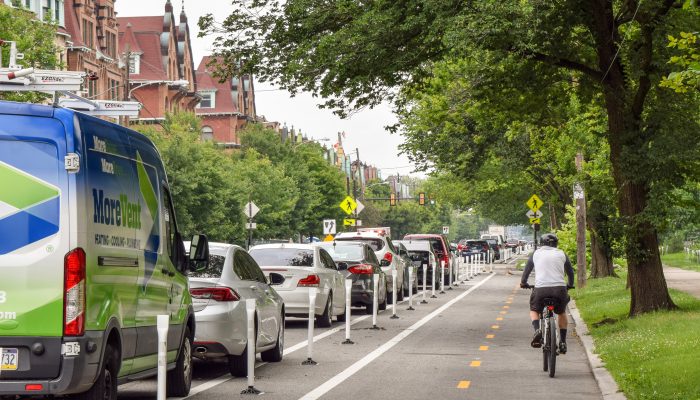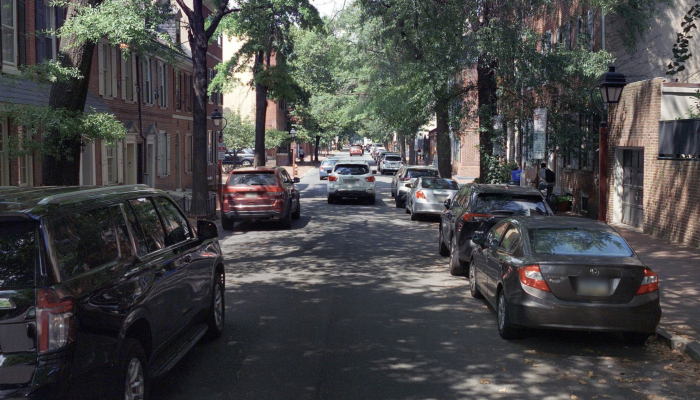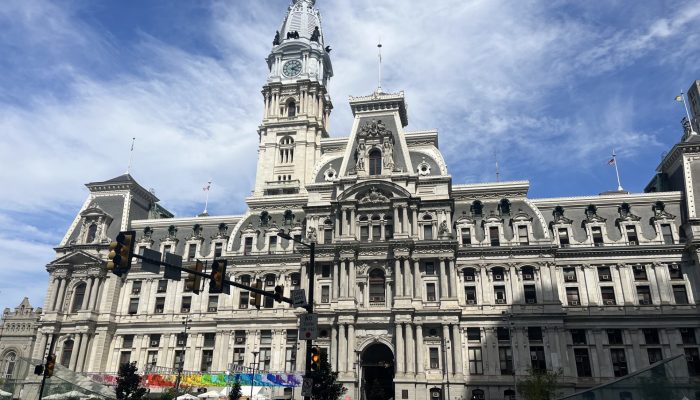In 2021, the City of Philadelphia worked with Kittleson and Associates to conduct a study to better understand the safety benefits, operational effectiveness, and usage impacts of parking separated bike lanes (PSBLs). As part of our commitment to Vision Zero, creating a high-quality bicycling network is essential in creating a transportation system that benefits everyone in our city.
About parking separated bike lanes (PSBLs)
Parking separated bike lanes (PSBLs) are in-street bikeways that are separated from moving motor vehicle traffic by a parking lane and a buffer area. PSBLs dedicate a separate and defined space for people bicycling using pavement marking, signage, vertical elements, and intersection treatments. They are accessible to people of all ages and abilities and have been shown to increase people bicycling due to the comfort and safety of the lanes.
In the City’s study, safety data from peer cities were reviewed to evaluate the effectiveness of PSBLs. Many of the reviewed case studies found that the installation of PSBLs reduce crash rates for motor vehicle drivers, bicyclists, and pedestrians, especially at mid-block locations where crash injuries tend to be most severe. PSBLs were also found to reduce people biking on the sidewalk, lower vehicle speeds, reduce interaction between people driving and bicycling, and eliminate the risk of side swiping or overtaking people bicycling. Crashes involving a driver overtaking a person bicycling are the leading cause of fatalities for people bicycling in the US.
PSBLs in Philadelphia
To study the impacts of PSBLs in Philadelphia, the City developed a pilot project on several PennDOT roads to install PSBLs, including Market Street, JFK Boulevard, and Race Street in Center City and the Chestnut Street Bridge, among others. Prior to the pilot, most of the City’s bicycle network included painted bicycle lanes adjacent to vehicular traffic. In conditions with no separated infrastructure, motor vehicles were more likely to stop, park, and pass in the bike lanes, requiring cyclists to weave in and out of traffic in comparison to conditions with PSBLs.
Key Findings
Analysis of project locations before and after the installation of the pilot PSBLs in Philadelphia produced the following key findings :
- Crashes – Small decrease in total crashes and decrease in number of fatalities.
- Vehicle Speeds – Decrease of 6% in speeds across all time periods.
- Bike Counts – 96% increase in the number of bikes where PSBL’s had been installed , particularly on JFK Boulevard and Market Street in Center City.
- Transit Vehicle Speeds – Modest decrease in average transit vehicle speeds.
Evaluation
In addition to the PSBLs on Market Street and JFK Boulevard, the City and PennDOT also have constructed four additional pilot PSBLs, and additional projects are in final design phases. As these facilities continue to roll out, the City plans to:
- Continue to collect data and monitor operations on PSBLs
- Update before and after evaluation as new data are collected
- Share data with outside agencies to help with the development of safety benchmarks known as crash modification factors for PSBLs
- Consider costs and benefits of more permanent vertical element
Next Steps
The State Senate Transportation Committee is holding a hearing on the future of parking separated bike lanes on April 4, 2022. Without the passage of H.B. 140, future parking separated bike lanes on state routes, like Chestnut St or Lehigh Avenue, are in jeopardy. The City, in partnership with towns and municipalities across the Commonwealth, supports speedy passage of this legislation.




